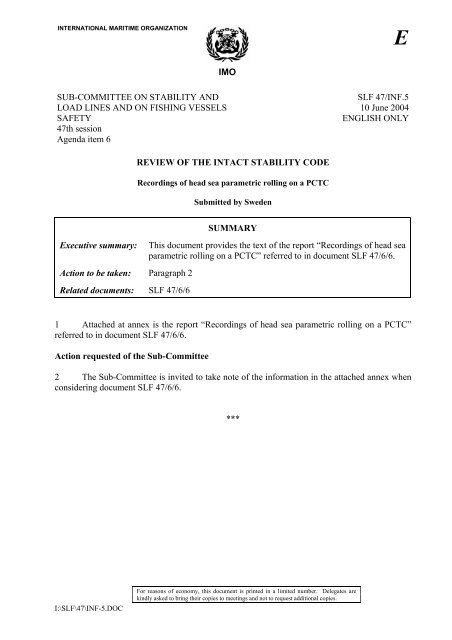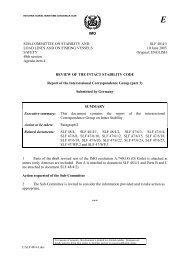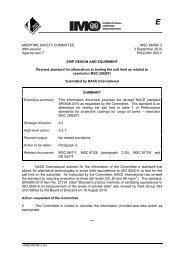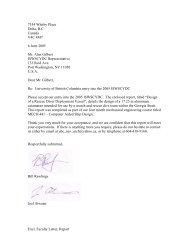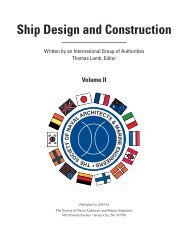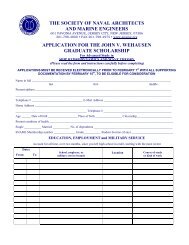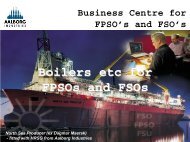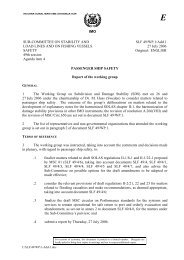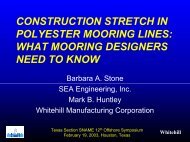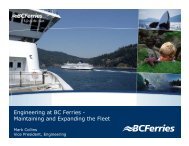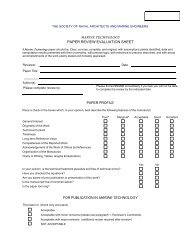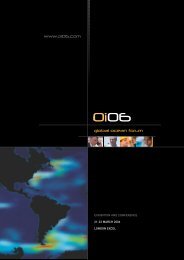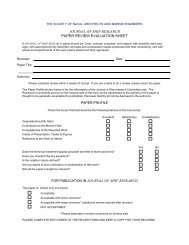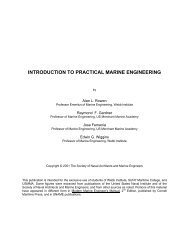SLF 47/Inf.5 - SNAME.org
SLF 47/Inf.5 - SNAME.org
SLF 47/Inf.5 - SNAME.org
Create successful ePaper yourself
Turn your PDF publications into a flip-book with our unique Google optimized e-Paper software.
INTERNATIONAL MARITIME ORGANIZATION<br />
E<br />
IMO<br />
SUB-COMMITTEE ON STABILITY AND<br />
LOAD LINES AND ON FISHING VESSELS<br />
SAFETY<br />
<strong>47</strong>th session<br />
Agenda item 6<br />
<strong>SLF</strong> <strong>47</strong>/INF.5<br />
10 June 2004<br />
ENGLISH ONLY<br />
REVIEW OF THE INTACT STABILITY CODE<br />
Recordings of head sea parametric rolling on a PCTC<br />
Submitted by Sweden<br />
Executive summary:<br />
Action to be taken: Paragraph 2<br />
Related documents: <strong>SLF</strong> <strong>47</strong>/6/6<br />
SUMMARY<br />
This document provides the text of the report “Recordings of head sea<br />
parametric rolling on a PCTC” referred to in document <strong>SLF</strong> <strong>47</strong>/6/6.<br />
1 Attached at annex is the report “Recordings of head sea parametric rolling on a PCTC”<br />
referred to in document <strong>SLF</strong> <strong>47</strong>/6/6.<br />
Action requested of the Sub-Committee<br />
2 The Sub-Committee is invited to take note of the information in the attached annex when<br />
considering document <strong>SLF</strong> <strong>47</strong>/6/6.<br />
***<br />
I:\<strong>SLF</strong>\<strong>47</strong>\INF-5.DOC<br />
For reasons of economy, this document is printed in a limited number. Delegates are<br />
kindly asked to bring their copies to meetings and not to request additional copies.
Recordings of head-sea parametric rolling on a PCTC 1(9)<br />
Recordings of head-sea parametric rolling on a PCTC<br />
Mikael Palmquist, Seaware AB, e-mail: mikael.palmquist@seaware.se<br />
Christer Nygren, Wallenius Marine AB<br />
Summary:<br />
This report presents data that was recorded on the PCTC M/V Aida between February 1 and 4, 2004.<br />
On this occasion, the ship encountered head sea with significant wave height 5-6 m and travelled with<br />
reduced speed 8-10 knots. At five different occasions parametric rolling evolved, with roll angles up to<br />
17 degrees. The strong pitch-roll coupling during head-sea parametric rolling is clearly demonstrated<br />
by recorded motion time series. When relating these recordings to another incident of heavy rolling (up<br />
to 50 degrees read off inclinometer) in head sea in February 2003 on Aida, it is found that the<br />
conditions seem to have been very similar, except for that the significant wave height was larger at that<br />
time.<br />
The recordings were made by an on-board operational decision support system. This system<br />
implements MSC/Circ.707 as a basis for operational support regarding dynamic stability phenomena<br />
such as parametric rolling. When running the system in playback mode with modified settings, i.e.<br />
reduced wave height threshold and including also head sea, warnings for parametric rolling are issued<br />
in route planning mode two days ahead as well as in automatic mode 10 hours prior to the first<br />
occurrence.<br />
Finally, revision of MSC/Circ.707 and the importance of operational guidance are briefly discussed.<br />
1 Introduction<br />
In February 2003, the Wallenius PCTC M/V Aida experienced sudden violent rolling in rough head sea<br />
southwest of the Azores. Roll angles as large as 50 degrees were read off the bridge inclinometer.<br />
When this incident was post-analysed it was found that the conditions, in terms of the relation of wave<br />
encounter period and natural roll period, were such that parametric rolling was the most likely cause.<br />
Partly due to this incident, M/V Aida was equipped with a Seaware EnRoute Live ® system in<br />
December 2003 for trial during the winter.<br />
The EnRoute system is an on-board based operational decision support system. It includes both voyage<br />
planning based on weather forecasts and real-time numerical ship dynamic simulations, 6 d.o.f. motion<br />
measurements, on site wave spectrum evaluation and guidance to the master in dangerous situations.<br />
Examples of dynamic effects for which the system can provide warnings and guidance are slamming,<br />
green water on deck, excessive cargo lashing forces and dynamic stability. In addition to this it<br />
provides a recording functionality that continuously records parameters such as ship motions, wind,<br />
ship speed and heading, evaluated seastate and more. Thanks to the recording functionality, parametric<br />
rolling has now, to the authors’ knowledge for the first time ever, been recorded during normal ship<br />
service.<br />
This report presents data that was recorded on M/V Aida in heavy weather conditions between<br />
February 1 and 4, 2004, on a voyage from Southampton to New York. On this occasion, Aida<br />
encountered heading sea with significant wave height 5-6 m and travelled with reduced speed 8-10<br />
knots west of the Azores. At five different occasions parametric rolling evolved. Luckily, the rolling<br />
did not reach the extreme amplitudes of last year’s incident.<br />
2 Recorded data<br />
2.1 Voyage overview<br />
Figure 1 below shows recorded data during the entire voyage. The first graph shows measured heave,<br />
pitch and roll in terms of significant values during 2 minutes blocks. As seen, sudden and relatively<br />
large rolling occurred 5 times during 2 and 3 Feb. The second and third graphs show mean values of<br />
wind speed and relative wind direction during 2 minutes blocks. Relative wave direction is defined so<br />
that 0 degrees represents head wind (positive values means wind on starboard side, negative on port<br />
side). The fourth (lower) graph displays significant wave height and mean zero-crossing period as<br />
estimated by the EnRoute system.
Recordings of head-sea parametric rolling on a PCTC 2(9)<br />
18<br />
16<br />
14<br />
12<br />
10<br />
8<br />
6<br />
4<br />
2<br />
0<br />
Heave (m)<br />
Pitch (deg)<br />
Roll (deg)<br />
40<br />
30<br />
Wind speed (m/s)<br />
20<br />
10<br />
0<br />
150<br />
10 0<br />
50<br />
0<br />
-50<br />
-100<br />
-150<br />
Relative wind direction (deg)<br />
12<br />
10<br />
8<br />
6<br />
4<br />
2<br />
0<br />
01-30<br />
00:00<br />
01-31<br />
00:00<br />
02-01<br />
00:00<br />
Significant wave height (m)<br />
Mean zero-crossing period (s)<br />
02-02<br />
00:00<br />
02-03<br />
00:00<br />
02-04<br />
00:00<br />
02-05<br />
00:00<br />
02-06<br />
00:00<br />
02-07<br />
00:00<br />
02-08<br />
00:00<br />
02-09<br />
00:00<br />
Ti m e ( M M - D D H H :MM )<br />
Figure 1. Overview of the voyage in terms of recorded motions, wind and wave conditions as estimated<br />
by Seaware EnRoute Live.<br />
2.2 Recorded roll motion time series<br />
Figures 2-6 show the roll motion time series of the 5 events of large rolling identified from the voyage<br />
overview. In all of these events, the roll amplitude increases quite rapidly, followed by a decrease back<br />
to the original amplitude level. The fact that the roll motion suddenly increases from about 2-3 degrees<br />
up to as much as 17 degrees in a few cycles (e.g. figure 6) in heading waves clearly indicates the<br />
presence of a non-linear phenomenon.<br />
Roll (deg)<br />
Measured roll. Reference time (t=0) is 2004-02-02 12:41:24UTC<br />
8<br />
6<br />
4<br />
2<br />
0<br />
-2<br />
-4<br />
-6<br />
-8<br />
-10<br />
-12<br />
0 100 200 300 400Time (s) 500 600 700 800 900<br />
Figure 2. Measured roll motion 2004-02-02, reference time 12:41 UTC
Recordings of head-sea parametric rolling on a PCTC 3(9)<br />
Roll (deg)<br />
Measured roll. Reference time (t=0) is 2004-02-02 14:49:24UTC<br />
20<br />
15<br />
10<br />
5<br />
0<br />
-5<br />
-10<br />
-15<br />
-20<br />
0 100 200 300 400Time (s) 500 600 700 800 900<br />
Figure 3. Measured roll motion 2004-02-02, reference time 14:49 UTC<br />
15<br />
Measured roll. Reference time (t=0) is 2004-02-03 06:41:22UTC<br />
Roll (deg)<br />
10<br />
5<br />
0<br />
-5<br />
-10<br />
-15<br />
0 100 200 300 400 Time 500(s)<br />
600 700 800 900 1000<br />
Figure 4. Measured roll motion 2004-02-03, reference time 06:41 UTC<br />
15<br />
Measured roll. Reference time (t=0) is 2004-02-03 15:17:39UTC<br />
Roll (deg)<br />
10<br />
5<br />
0<br />
-5<br />
-10<br />
-15<br />
0 100 200 300 400Time (s) 500 600 700 800 900<br />
Figure 5. Measured roll motion 2004-02-03, reference time 15:17 UTC<br />
Roll (deg)<br />
Measured roll. Reference time (t=0) is 2004-02-03 15:58:11UTC<br />
20<br />
15<br />
10<br />
5<br />
0<br />
-5<br />
-10<br />
-15<br />
-20<br />
0 100 200 300 400Time (s) 500 600 700 800 900<br />
Figure 6. Measured roll motion 2004-02-03, reference time 15:58 UTC
Recordings of head-sea parametric rolling on a PCTC 4(9)<br />
2.3 Roll and pitch coupling<br />
Analysis of the correlation between roll and pitch motion during the events of large roll angles provides<br />
very clear examples of parametric rolling. As seen in figure 7 and 8, the pitch period is half the period<br />
of roll during the roll build-up, and is in-phase in such a way that roll extremes coincides with<br />
maximum bow down pitch combined with minimum heave. It is also interesting to note that rolling<br />
starts to diminish when the pitch amplitude decreases or becomes phase shifted relative to the rolling.<br />
In order to archive a better apprehension of the nature of parametric rolling, an animation was created<br />
in which a 3-D model of the ship moves according to the measured motions (2004-02-03 at 16 UTC,<br />
figure 6). A wave surface was added to the animation scene, consisting of regular waves whose wave<br />
period equals to the peak period of the estimated wave spectrum at the corresponding time. The<br />
phasing between the regular wave and the ship was set so that it corresponded to parametric rolling<br />
conditions (wave crest midship at zero roll, wave trough midship at maximum absolute roll angle). The<br />
images of figure 9 are taken from this animation.<br />
It is well known that parametric rolling in head seas involves a strong pitch-roll coupling. Due to this<br />
coupling, the relation between the natural periods of pitch and roll is an interesting factor. In case the<br />
natural pitch period is half of the natural roll period (and therefore equal to the encounter wave period<br />
in parametric rolling conditions), parametric rolling is further encouraged. It should be noted that this<br />
coupling is less important in following waves. On this voyage the loading condition was such that the<br />
natural pitch period actually was close to half the natural roll period (table 1).<br />
The possibility of predicting natural periods of pitch and roll in operational decision support systems<br />
enables early warnings in the route planning stage using weather forecasts with proper wave data.<br />
Table 1 compares predicted (as calculated when leaving Southampton) and measured natural periods of<br />
pitch and roll.<br />
Table 1. Comparison of predicted and measured natural periods.<br />
Predicted by Seaware EnRoute Live From measurements<br />
Natural roll period 23.3 s 22.5 – 24 s<br />
Natural pitch period 11.4 s 10 – 11 s<br />
Measured motion time series. Reference time (t=0) is 2004-02-02 14:55:48UTC<br />
15<br />
10<br />
Heave (m)<br />
Pitch (deg)<br />
Roll (deg)<br />
5<br />
Motions<br />
0<br />
-5<br />
-10<br />
-15<br />
40 60 80 100 120 140 160 180 200 220<br />
Time (s)<br />
Figure 7. Close-up of time series in figure 3, including also heave and pitch.
Recordings of head-sea parametric rolling on a PCTC 5(9)<br />
20<br />
15<br />
10<br />
Measured motion time series. Reference time (t=0) is 2004-02-03 16:06:44UTC<br />
Heave (m)<br />
Pitch (deg)<br />
Roll (deg)<br />
5<br />
Motions<br />
0<br />
-5<br />
-10<br />
-15<br />
-20<br />
0 20 40 60 80 100 120<br />
Time (s)<br />
Figure 8. Close-up of time series in figure 6, including also heave and pitch.<br />
Figure 9. Snapshots from animation of the time series in figure 6 and 8. The maximum pitch (bow<br />
down) coincides with roll extremes and minimum heave.<br />
2.4 Wave conditions<br />
The wave spectra evaluated by the EnRoute system at the times of parametric rolling has peak periods<br />
that, when transformed to encounter periods with respect to ship speed and wave direction, are very<br />
close to parametric resonance conditions, i.e. half the natural roll period. In order to confirm these<br />
spectra, hindcast wave spectra were obtained from the Swedish Meteorological and Hydrological<br />
Institute (SMHI) and compared against evaluated wave spectra. The hindcast wave spectra represent<br />
analysis fields for the time of concern, computed at European Centre for Medium-Range Weather<br />
Forecasts (ECMWF). In figure 10 and table 2, hindcast and evaluated wave spectra for the position of<br />
M/V Aida at 1200 UTC 2004-02-02 shows fairly good agreement, having almost identical peak<br />
periods. The wave spectra in figure 10 include both wind waves and swell energy. The evaluated wave<br />
spectra indicate however a multiple peak spectra with more wind wave energy (which seems most<br />
reasonable with respect to the wind speed at this time). Table 3 is a corresponding comparison for<br />
2004-02-03 at the time of large rolling. These also compare fairly well, although the evaluated peak<br />
period is approximately 1.5 s larger than for the hindcasts.<br />
As mentioned in the introduction of this report, M/V Aida experienced far more extreme rolling in head<br />
sea last year, in February 2003. As the loading conditions were quite similar, it is interesting to<br />
compare hindcast wave spectra for the two occasions. In figure 10 it can be seen that the hindcast wave<br />
spectra for 2003-02-17, i.e. last years incident, is very similar to the hindcast wave spectra for 2004-02-<br />
02. The peak periods are quite the same and so is the spectral shape, i.e. they are both rather narrow<br />
banded. This strengthens the opinion that last years incident was actually caused by parametric rolling.<br />
It may be noted that the hindcast wave spectra were originally obtained as 3-dimensional spectra. The<br />
3-dimensional spectra were quite centered and symmetric around the main direction. In order to be able<br />
to compare them to the 2-dimensional spectra evaluated by the system, the spectral shape at their main<br />
wave direction was scaled to the same energy content as the original 3-dimensional spectra.
Recordings of head-sea parametric rolling on a PCTC 6(9)<br />
Spectral density (m2s)<br />
14<br />
12<br />
10<br />
8<br />
6<br />
4<br />
Wave spectra comparison<br />
Hindcast 2003-02-17, 1200 UTC<br />
Hindcast 2004-02-02, 1200 UTC<br />
Seaware EnRoute Live 2004-02-02 1200 UTC<br />
Figure 10. Comparison<br />
of wave spectra:<br />
Estimated wave spectra<br />
(Seaware EnRoute Live)<br />
2004-02-02, hindcast<br />
wave spectra 2004-02-<br />
02 and hindcast wave<br />
spectra for last years<br />
incident 2003-02-17.<br />
The peak periods were<br />
almost identical at the<br />
two occasions.<br />
2<br />
0<br />
0 0.2 0.4 0.6 0.8 1 1.2 1.4 1.6 1.8 2<br />
Wave frequency (rad/s)<br />
Table 2. Comparison of significant wave height and peak period 2004-02-02 – hindvast vs evaluated.<br />
Sign. wave height, H s (m) Peak period, T p (s)<br />
Hindcast 5.6 13.4<br />
EnRoute Live ~5.2-6.0 ~12.7-13.2<br />
Table 3. Comparison of significant wave height and peak period 2004-02-03 - hindvast vs evaluated.<br />
Sign. wave height, H s (m) Peak period, T p (s)<br />
Hindcast 12UTC 4.5 12.6<br />
Hindcast 18UTC 4.3 12.6<br />
EnRoute Live 16UTC ~5.1-6.0 ~13.5-14.0<br />
2.5 Measured natural roll periods and calculated encounter periods<br />
As stated earlier, parametrically excited roll is most likely to occur in heading or following waves when<br />
the encounter period is half the natural roll period. The encounter period is defined as:<br />
T = 1<br />
e 1 2πU<br />
cos( β )<br />
, where T is the wave period (s), U is the ship speed (m/s) and β is the<br />
−<br />
T T<br />
2 g<br />
relative wave direction (head waves is here defined as 180 degrees, in opposite to figure 1). Hence the<br />
ship speed and relative wave direction are important factors regarding parametric roll.<br />
The EnRoute system, in automatic mode, continuously calculates the natural roll period (based on<br />
measured roll motion) and the encounter period (based on evaluated wave spectra and ship<br />
speed/heading). In figure 11, some important factors with concern to parametric roll are plotted for a<br />
period around the two events of rolling during 2004-02-03. A slight increase of wave peak period along<br />
with a moderate decrease of speed (probably due to wave impact) matches the events of parametric<br />
roll, “fulfilling the requirements” for parametric rolling to evolve. It is also possible that water on the<br />
forecastle could contribute in triggering the parametric roll by its heeling moment. The master of M/V<br />
Aida suspects that the built-in forecastle could have been filled with water just before the events of<br />
large rolling.
Recordings of head-sea parametric rolling on a PCTC 7(9)<br />
Parametric roll<br />
24<br />
22<br />
20<br />
18<br />
16<br />
14<br />
12<br />
10<br />
Measured natural roll period (s)<br />
Encounter peak period (s)<br />
Wave spectrum peak period (s)<br />
285<br />
280<br />
275<br />
Course (deg)<br />
12<br />
11<br />
10<br />
9<br />
Speed (kts)<br />
8<br />
0 10 20 30 40 50 60 70 80 90<br />
Time (minutes)<br />
Figure 11. Important factors with concern to parametric roll for a period of time during 2004-02-03.<br />
3 Operational guidance regarding parametric rolling<br />
3.1 Implementation of MSC/Circ.707 in Seaware EnRoute Live<br />
Seaware EnRoute Live deals with dynamic stability, such as parametrically excited roll, in route<br />
planning mode, based on weather forecasts, as well as in automatic mode, based on measurements and<br />
evaluated seastate.<br />
The warning functionality in the software regarding dynamic stability is implemented according to<br />
IMO MSC/Circ.707 [1] but provides the possibility to override default threshold values for average<br />
wave length and wave height as well as to extend the formulation to cover all wave directions. The<br />
MSC/Circ.707 guidelines are, in its original form, limited to cover dynamic stability issues in following<br />
and quartering seas. It has for quite some time been known that parametric roll is more likely to occur<br />
in heading waves for certain ship types such as RoRo and large container ships, and that head-sea<br />
parametric roll can in fact be more critical due to strong pitch-roll coupling (leading to large loads on<br />
lashings due to the combined effect of in-phase rolling and pitching). Therefore, the system provides<br />
the possibility to extend the dynamic stability criteria to cover all wave directions. Since it is also well<br />
known that the sensitivity for dynamic stability problems differ a lot between different ships, e.g. [4],<br />
the possibility to modify the threshold values is also provided. This applies in particular to the<br />
significant wave height threshold value. Because of recent head-sea parametric roll incidents with post-<br />
Panamax container ships [2], a revision of MSC/Circ.707 is currently being addressed by IMO, e.g. [3].<br />
The default value for the wave height threshold, according to MSC/Circ707, is 7.6 m for M/V Aida.<br />
However, with facts at hand, it is reasonable to state that a wave height threshold of 7.6 m is too large<br />
for this ship. It has now been reduced to 5 m since we now know it actually occurred in significant<br />
wave heights between 5 and 6 meters.
Recordings of head-sea parametric rolling on a PCTC 8(9)<br />
3.2 Playback of recorded data<br />
During the voyage of concern, the EnRoute system was actively used to adjust the ship speed in order<br />
to avoid bow slamming as far as possible, and the user settings regarding parametric rolling were set<br />
according to MSC/Circ.707, i.e. only following/quartering waves. Consequently, no warnings were<br />
issued since the ship traveled in head sea. It is however possible to use the system in a playback mode<br />
using received weather forecasts and recorded sensor signals, allowing the user to make re-runs with<br />
changed settings. This has been made for the entire voyage using modified settings regarding<br />
parametric rolling, in which all wave directions have been considered and where the wave height<br />
threshold value has been reduced from 7.6 to 5 m.<br />
When the route planning module is re-evaluated using the adjusted dynamic stability settings, the<br />
parametric roll warning is activated for one leg – a leg during which parametric roll occurred 2004-02-<br />
02. In this re-run, a forecast received 2004-01-31 was used - two days ahead of the event. Figure 12 is a<br />
screen dump from this re-run.<br />
Figure 12. Screen dump<br />
from the route planning<br />
module. A parametric<br />
roll warning is raised<br />
for one sub-leg (drawn<br />
in red) during 2004-02-<br />
02, two days ahead of<br />
the event.<br />
Figure 13 presents the result of a playback in automatic mode using adjusted dynamic stability settings,<br />
showing that warnings would have been raised if the modified criteria had been set during the voyage.<br />
Reference time (t=0) is 2004-01-31, 18:34 UTC<br />
20<br />
Parametric rolling<br />
15 Significant roll (deg)<br />
10<br />
5<br />
0<br />
Parametric roll warning active<br />
Advice graph displaying parametric roll warning area<br />
0 10 20 30 40 50 60 70 80 90<br />
Time (hours)<br />
Figure 13. Playback of a part of the voyage. The middle graph shows when the parametric roll<br />
warning was issued (at present condition). The lower graph shows when the advice graph displayed<br />
any warning zones (red area) at any operating condition within the bounds of the advice functionality<br />
(0-23 kts, + - 30 degrees off current course).
Recordings of head-sea parametric rolling on a PCTC 9(9)<br />
3.3 Regarding revision of MSC/Circ.707<br />
The need to extend MSC/Circ.707 to cover also head sea regarding parametric rolling has already been<br />
addressed within IMO, e.g. [3]. The findings of this report provide further grounds for such a revision.<br />
However, the need for further development is also clear. The complexity of dynamic stability<br />
phenomena will probably lead such development towards more rational guidelines or criteria with<br />
focus on operation rather than design. It is a fact that the properties that make, for instance, RoRo and<br />
container ships sensitive to parametric rolling and pure loss of stability are inherent in the actual<br />
concept of those ship types. Attempts to incorporate effects of stability variations in intact stability<br />
regulations will most likely result in higher GM’s, which may not lead to overall improvement due to<br />
increased lateral accelerations. As operational aspects are vital, it is the authors’ opinion that the main<br />
target should be further development of methods for short-term risk assessment that can be put into<br />
practice in ship operation, for instance implemented in operational decision support systems. Such<br />
methods should deal with the specific hull form, taking factors like wave direction, wave spectra<br />
bandwidth and multiple wave systems into account.<br />
Another reflection concerns the awareness of these phenomena among ship officers. By the authors’<br />
experience, very few have heard about parametric rolling, while several seems to recognise the<br />
situation when its nature is described, preferably by showing an animation or model experiment video.<br />
Hence, incorporation of dynamic stability, along with intact and damage stability, in the education of<br />
ship officers may also play an important role.<br />
4 Conclusions<br />
This report presents unique recordings of head sea parametric rolling. It has been shown that the<br />
conditions, in terms of dominant encounter period and natural roll period, matched the primary<br />
parametric resonance very well. The strong pitch-roll coupling during the events of parametric rolling<br />
is also clearly demonstrated.<br />
The recordings of parametric rolling of this report occurred in seastate that hardly can be described as<br />
extreme in any way, having a significant wave height of 5-6 meter and a peak period of 13-14 sec. The<br />
maximum rolling reached 17 degrees and no damages to ship or cargo occurred. When relating these<br />
recordings to the incident of heavy rolling (up to 50 degrees read off inclinometer) in head sea in<br />
February 2003 it is found that the conditions were very similar, except for that the significant wave<br />
height was larger - approximately 7-8 m according to hindcast wave spectra.<br />
It has been possible to adjust the settings, in terms of threshold values and directional concern, in<br />
Seaware EnRoute Live based on the recorded data. When running the system in playback mode with<br />
modified settings, using received weather forecasts and recorded sensor signals from the voyage,<br />
warnings for parametric rolling are issued in route planning mode two days ahead as well as in<br />
automatic (real-time) mode 10 hours prior to the first occurrence.<br />
In order to improve on board guidance, development of rational methods for short-term risk assessment<br />
should continue since the risk for dynamic stability problems can be significantly reduced by weather<br />
routing and proper choice of speed and heading.<br />
5 References<br />
1. Guidance to the master for avoiding dangerous situations in following and quartering seas, IMO<br />
MSC/Circ.707, IMO London, 1995<br />
2. Head-sea parametric rolling and its influence on container lashing systems, <strong>SLF</strong> 45/6/7, IMO<br />
2002<br />
3. Proposals with regard to the scope of revising the IS code and the related MSC/Circ.707, <strong>SLF</strong><br />
45/6/2, IMO 2002<br />
4. Palmquist, M.: On the Statistical Properties of the Metacentric Height of Ships in Following Seas,<br />
Fifth Intl. Conf. On Stability and Ocean Vehicles (STAB 94), Florida, Nov. 1994


